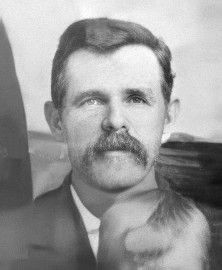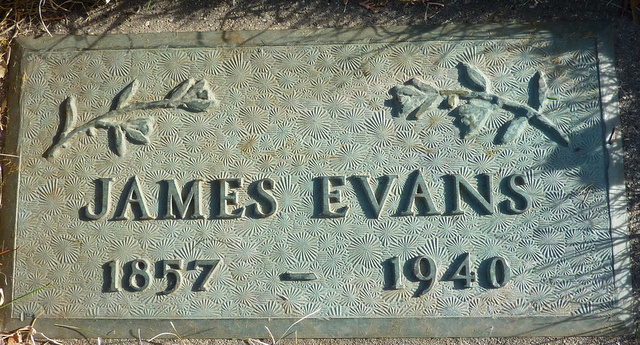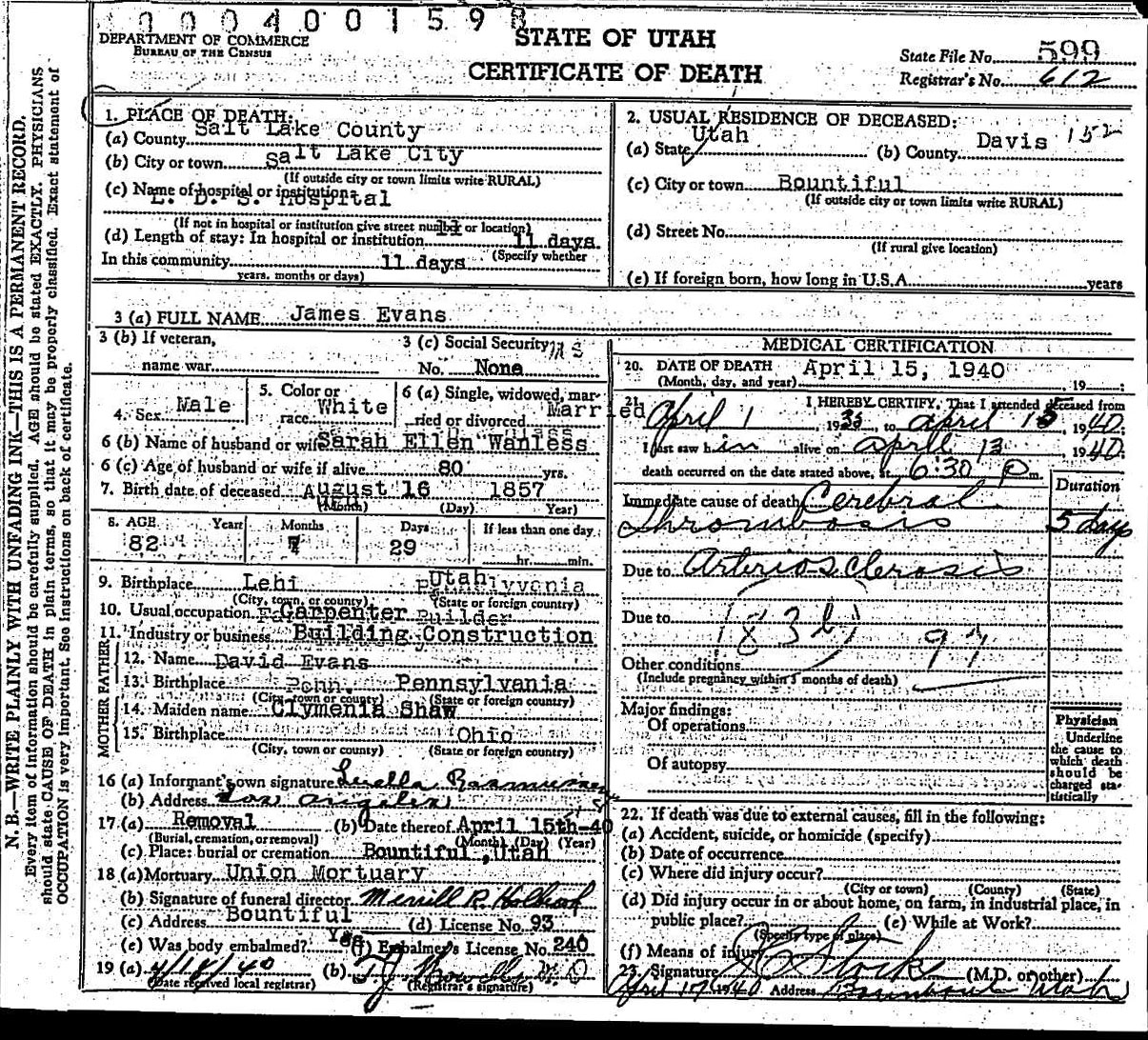In his early life, he made a trip to Arizona by team and wagon, and trip to Eastern Utah and Western Colorado with an old trapper by the name of Johnson, where they spent the winter trapping for furs on the White River, thus experiencing many vicissitudes of travel common to those early times in the West.
He learned the carpenter trade under the direction of Peter Lottensock, a skilled workman.
In April 1882, he married Sarah Ellen Wanlass in the Salt Lake Endowment House. She is the daughter of William and Mary Odell Wanlass, and was born near Richmond, Missouri, February 26, 1860.
He worked for Archie and Robert Gardner, who were among the first to build and operate saw mills in Utah. He followed the carpenter trade and construction work most of his life, and took an active part as a carpenter in building the first sugar factory in the intermountain area at Lehi, Utah. He assisted in the erection of some of the first cyanide plants in the United States, at Mercur, Utah.
In the fall of 1889, he responded to the call by the First Presidency of the L.D.S. Church to go on a mission to England. He spent two years in the mission field. During this time, he enjoyed good health and had many rich experiences preaching the Gospel. He was an honest, sincere and courageous man, and was free from hypocrisy.
Later, learning of opportunities to acquire land in Alberta. Canada, he moved there in the early Spring of 1898, with many other Utah families, who went there as community builders. He traveled by team and wagon, leaving Lehi, Utah, and arriving in Cardston, Alberta, May 7, 1898. It took six weeks to make the trip. This was eleven years after Cardston was first settled. Here he built his first home in Canada, hauling the lumber by team from McLeod, Alberta, the nearest saw mill.
In association with J. C. Cahoon, contractor and builder, he started the first lumber yard in Cardston, freighting their materials from McLeod, some 40 miles distant.
In the movement of the L.D.S. Church to colonize under the Irrigation Canal to be built, Pres. C. O. Card called James Evans to join with other families to make new homes under the Canal area. He was engaged by the Church to build the first houses on the town sites of Magrath and Sterling, six houses in each place. These were available to the settlers. This work was started in the early Spring of 1899, and finished in the late summer of the same year. The remuneration for his labor was 50% cash and 50% in land credit. This enabled him to get his land and start a new home in Magrath, where he farmed and lived for several years, and took a prominent part in civic and church activities.
Because of climate conditions, his doctor advised him to move to a warmer climate. With his family, he moved to Burley, Idaho. Their stay there was some three years. From there, they moved to Bountiful, Utah. There he remained and built a home. He became employed by the Utah-Idaho Sugar Company, doing construction work in the several states where they operated. He remained with them until he retired because of old age.
In the many places where he lived, it seemed to fall his lot to contribute or help in the building of new churches, which he freely did.
James Evans was naturally a pioneer and traveled to many parts of the country, looking for places suitable for new homes.
He died on April 15, 1940, at the age of 83 years in his home in Bountiful, Utah. Many relatives and friends were in attendance at his funeral.
-written by his son, James W. Evans
NOTE: This history indicates that he died in his home in Bountiful; however, his death certificate lists that he died at LDS Hospital in Salt Lake City.
In his early life, he made a trip to Arizona by team and wagon, and trip to Eastern Utah and Western Colorado with an old trapper by the name of Johnson, where they spent the winter trapping for furs on the White River, thus experiencing many vicissitudes of travel common to those early times in the West.
He learned the carpenter trade under the direction of Peter Lottensock, a skilled workman.
In April 1882, he married Sarah Ellen Wanlass in the Salt Lake Endowment House. She is the daughter of William and Mary Odell Wanlass, and was born near Richmond, Missouri, February 26, 1860.
He worked for Archie and Robert Gardner, who were among the first to build and operate saw mills in Utah. He followed the carpenter trade and construction work most of his life, and took an active part as a carpenter in building the first sugar factory in the intermountain area at Lehi, Utah. He assisted in the erection of some of the first cyanide plants in the United States, at Mercur, Utah.
In the fall of 1889, he responded to the call by the First Presidency of the L.D.S. Church to go on a mission to England. He spent two years in the mission field. During this time, he enjoyed good health and had many rich experiences preaching the Gospel. He was an honest, sincere and courageous man, and was free from hypocrisy.
Later, learning of opportunities to acquire land in Alberta. Canada, he moved there in the early Spring of 1898, with many other Utah families, who went there as community builders. He traveled by team and wagon, leaving Lehi, Utah, and arriving in Cardston, Alberta, May 7, 1898. It took six weeks to make the trip. This was eleven years after Cardston was first settled. Here he built his first home in Canada, hauling the lumber by team from McLeod, Alberta, the nearest saw mill.
In association with J. C. Cahoon, contractor and builder, he started the first lumber yard in Cardston, freighting their materials from McLeod, some 40 miles distant.
In the movement of the L.D.S. Church to colonize under the Irrigation Canal to be built, Pres. C. O. Card called James Evans to join with other families to make new homes under the Canal area. He was engaged by the Church to build the first houses on the town sites of Magrath and Sterling, six houses in each place. These were available to the settlers. This work was started in the early Spring of 1899, and finished in the late summer of the same year. The remuneration for his labor was 50% cash and 50% in land credit. This enabled him to get his land and start a new home in Magrath, where he farmed and lived for several years, and took a prominent part in civic and church activities.
Because of climate conditions, his doctor advised him to move to a warmer climate. With his family, he moved to Burley, Idaho. Their stay there was some three years. From there, they moved to Bountiful, Utah. There he remained and built a home. He became employed by the Utah-Idaho Sugar Company, doing construction work in the several states where they operated. He remained with them until he retired because of old age.
In the many places where he lived, it seemed to fall his lot to contribute or help in the building of new churches, which he freely did.
James Evans was naturally a pioneer and traveled to many parts of the country, looking for places suitable for new homes.
He died on April 15, 1940, at the age of 83 years in his home in Bountiful, Utah. Many relatives and friends were in attendance at his funeral.
-written by his son, James W. Evans
NOTE: This history indicates that he died in his home in Bountiful; however, his death certificate lists that he died at LDS Hospital in Salt Lake City.
Family Members
-
![]()
Eliza Jane Evans Hinckley
1827–1850
-
![]()
Pvt Israel Evans
1828–1896
-
![]()
Henry Beck Evans
1830–1911
-
![]()
Mary Ann Evans Glines
1832–1884
-
Margaret Evans
1835–1836
-
Arminta Evans
1838–1838
-
![]()
Emma Beck Evans Coleman
1840–1913
-
![]()
Martha Evans Winn
1842–1926
-
![]()
Amanda Evans Edwards
1844–1881
-
![]()
Abigail Evans Ellingson
1846–1932
-
![]()
Joseph H. Evans Sr
1847–1899
-
![]()
Sarah Evans Hodge
1849–1893
-
![]()
Susannah Evans Alldredge
1850–1932
-
![]()
Barbara Ann Evans Bush
1855–1926
-
![]()
Rozilla Evans Racker
1856–1940
-
![]()
George Coleman Evans
1858–1906
-
![]()
Prime Evans
1860–1901
-
![]()
Eleazer Evans
1861–1884
-
![]()
Mosiah Evans
1862–1921
-
![]()
John Holm Evans
1863–1864
-
![]()
Sarah Coleman Evans Taylor
1864–1946
-
![]()
Mary Ann Evans Wanlass
1864–1931
-
![]()
Margaret Christine Evans Turner
1865–1941
-
![]()
Jane Evans Bradshaw
1867–1919
-
![]()
Jacob Evans
1867–1953
-
![]()
Emma Jane Evans Taylor Roberts
1869–1942
-
![]()
Hannah Evans Anderson
1870–1953
-
![]()
Rachel Evans Wing
1874–1962
-
![]()
Ellen "Ella" Evans Manning
1875–1962
-
![]()
Clara Evans Goates
1876–1920
Sponsored by Ancestry
Advertisement
Advertisement







































